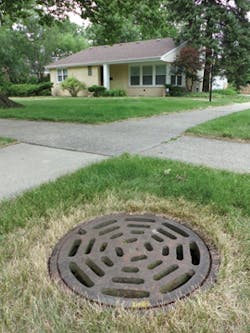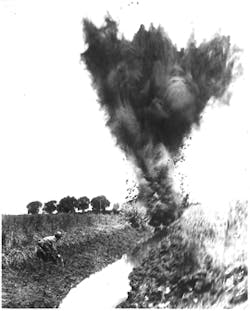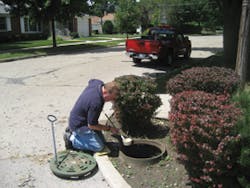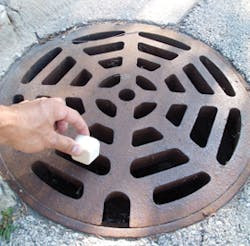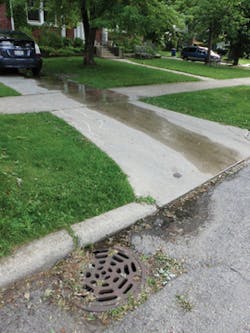While a necessity of life, water is associated with a variety of very important public health and environmental concerns. In particular, stormwater and dry-weather urban runoff (now collectively referred to as “stormwater”) have been directly and indirectly connected to numerous human diseases and maladies as well as to environmental damage and pollution. To mitigate these undesirable consequences, government agencies were created or expanded to address specific areas of concern, eventually growing to become the flood and stormwater management and mosquito control agencies we work in today. The common ancestry of these agencies has been largely forgotten, but the shared DNA can still be found within the missions of these two seemingly disparate groups as they strive to protect public and environmental health. In urbanized areas of the United States, stormwater management and mosquito control agencies share many of the same goals, work with the same structures, and face many of the same day-to-day and long-term challenges. To illustrate this point, five topics important to both groups are discussed.
Stormwater Infrastructure
The principal function of all modern flood and stormwater management agencies is to protect the health and safety of our communities through flood protection and water-quality improvements. To achieve this, stormwater infrastructure must be regularly maintained, repaired, improved, and expanded. Many mosquito control agencies also work with stormwater infrastructure to protect public health, particularly in urban and suburban areas. Stormwater infrastructure has been identified as a major source of mosquitoes in many metropolitan areas and in some cases is considered the single largest source. For example, storm drains and catch basins are the primary source of potentially disease-carrying mosquitoes in the greater Chicago metropolitan area, covering over 1,000 square miles. Within the Chicago city limits, the city’s vector control program focuses almost exclusively on catch basins, of which there are upward of 200,000. Likewise, in the suburbs north of Chicago, the North Shore Mosquito Abatement District (NSMAD) devotes approximately 75% of its control operations to treating more than 60,000 catch basins once or twice a season with mosquito larvicides (Figure 1). Much of the remaining control operations for NSMAD are focused on mile after mile of stormwater drainage ditches.
Figure 2. A historical example of collaborative efforts to reduce standing water and mosquitos in 1928. The Sanitary District of Chicago used dynamite to create ditches and drain large areas of water-logged land for the North Shore Mosquito Abatement District in Northfields, IL. Not surprisingly, there were more complaints of damage to homes than about mosquitos.
Water Management
Since ancient times, conveyance infrastructure has served to protect people and property against flooding by routing runoff water downstream and out of harm’s way as quickly and efficiently as possible. Pioneers in mosquito control also managed water, but focused on the removal of standing water sources in and around populated areas to protect people from swarms of blood-sucking mosquitoes and mosquito-borne diseases such as malaria and yellow fever. Water management engineers, including those that worked on creating the Panama Canal, played an integral role during the first organized mosquito control efforts in the early 1900s (Figure 2). In fact, for decades the most common hand tool used by mosquito control technicians was a shovel to dig channels and drain areas of standing water. Today, public health and safety is still a priority, but certain approaches to water management have changed to benefit the environment and preserve resources. Wetlands are now recognized as beneficial and are rarely drained for mosquito control or urban development, but rather are carefully managed to coexist with an ever-increasing human population. Also in sharp contrast to the past, we now consider the benefits of holding some runoff on site to replenish belowground aquifers, reduce the use of piped water, and decrease downstream erosion and pollution. The retention of stormwater runoff in engineered water-quality structures, water harvesting containers, and other structures, however, has created new sources for mosquito production that will require continuing collaboration to reach the best possible compromise for simultaneously protecting public health and water quality. In the meantime, both groups have been working toward a common goal of reducing the amount of dry-weather runoff in our cities (which contributes to downstream pollution and mosquito habitat) by promoting more judicious water use.
Maintenance
Stormwater infrastructure requires constant maintenance to ensure that it functions as intended. In older cities especially, aging infrastructure requires periodic repair from damage and sometimes-full replacement with larger-capacity pipes and channels to accommodate greater water volumes resulting from upstream population growth. Maintenance is critical to ensure flood protection, reduce downstream pollution, and preserve the function of engineered water-quality structures. Maintenance of stormwater infrastructure is equally important to reducing mosquito habitat. Cracked and sunken conveyances, debris buildups, unchecked plant growth, and other blockages all contribute to forming pools of standing water where mosquitoes can breed. These sources, even those deep underground, provide larval habitat for some of the most important disease-carrying species. Stormwater management agencies ensure the proper function of these systems through routine or “as needed” maintenance. However, mosquito control technicians often carry hand tools such as shovels to remove small blockages and restore water flow because mosquitoes are frequently associated with stagnant pools not large enough to trigger maintenance activities by stormwater management agencies. Both groups rely on proper maintenance of stormwater infrastructure to help achieve their goals.
Environmental Stewardship
The Clean Water Act sets protecting public health and welfare as a cornerstone of modern stormwater management agencies. Similarly, this describes the fundamental mission of mosquito control agencies, which endeavor to reduce negative outcomes resulting from mosquitoes on human health, public welfare, and property values. And while it may not be as immediately evident for mosquito control agencies as for stormwater management agencies, both are also stewards of environmental health. For example, control of mosquitoes that can transmit West Nile virus protects humans as well as domestic and wild animals including local and migratory birds that might otherwise be infected and succumb to this avian disease. Restoring tidal flows in salt marshes, unclogging streams impacted with sediment and trash, and managing invasive vegetation are other examples used for reducing mosquito populations that also benefit water quality and the environment. When pesticides must be used, most mosquito control agencies preferentially utilize biologically based and mosquito-specific control products such as Bacillus thuringiensis israelensis (Bti) rather than the broad-spectrum chemical formulations of the past (Figure 3). Being conscientious stewards of the environment and public health are roles heartily embraced by stormwater management and mosquito control agencies alike.
Moving Forward
If a “stormwater management agency” can be defined as an agency that 1) works with stormwater conveyance and water-quality infrastructure on a regular basis, 2) is dependent on the proper function and maintenance of this infrastructure, 3) benefits from increased surface water quality, and 4) has been created to protect public health, environmental health, and property values by addressing a surface water-based concern, then mosquito control agencies have a decent shot at such a title. Even the National Association of Flood and Stormwater Management Agencies describes its members as “public agencies whose function is the protection of lives, property, and economic activity from the adverse impacts of storm and flood waters”–a description that is also largely applicable to mosquito control agencies. But why might this matter? At a time when public agencies are asked to do more with fewer resources, increased interagency collaboration and communication could be the key to improving efficiency and meeting program objectives. Perhaps if we begin to think of our local mosquito control agencies as partners helping to fulfill the mission to protect health and environment, strong partnerships could more easily be established. Simply think of them as local “stormwater mosquito agencies.”
Interagency partnerships between stormwater management and mosquito control promise to deliver mutually beneficial results, and as water-quality regulations and policies become more stringent, interagency communication and cooperation will become increasingly important. Stormwater infrastructure, particularly in larger metropolitan areas, has to be routinely monitored and maintained to ensure it functions properly when needed. The size and complexity of some of these systems almost guarantees that stormwater management agencies would benefit from additional help. Since mosquito control agencies often have staff routinely working with stormwater structures, they represent an untapped resource for stormwater management agencies that function as additional “eyes and ears” in the field. For the most part, mosquito control technicians can identify malfunctioning structures and blockages that could be reported before they create potentially larger and more expensive problems and liabilities. Swift action by stormwater management agencies to mitigate reported problems would have the mutual benefit of reducing mosquito larval habitat after repairs or maintenance was performed.
On the flip side, as stormwater infrastructure continues to grow to meet new water-quality requirements, mosquito control agencies could benefit from assistance in locating and safely accessing potential mosquito breeding sources within the system. This is very important for mosquito control and disease prevention. The below-average rainfall observed in many areas of the country in 2012 led some to speculate that mosquito populations would be negatively affected. This may have been true for some species, but others flourished in urban stormwater infrastructure where dry-weather flows maintained standing water habitats (Figure 4). By the end of 2012, the number of human West Nile virus cases had reached the second highest on record in the United States. Closer interagency collaboration may help to reduce the risk of this and other mosquito-borne diseases in the future.
In closing, we encourage you to invite a mosquito control representative to give a talk at your next conference or write an article for your newsletter. Alternately, register as a participant and speaker at the next state or national conference on mosquito research and control. Ask mosquito control professionals for input in your next stormwater management manual and work with them to evaluate new stormwater products or design concepts. Most likely they will be happy to oblige, and the collaboration might lead to better designs, strategies, and protocols. When we start thinking of mosquito control agencies as valuable stormwater teammates, we all score points for public health and the environment.
Selected References
Anderson, J. F., F. J. Ferrandino, D. W. Dingman, A. J. Main, T. G. Andreadis, and J. Becnel. 2011. “Control of Mosquitoes in Catch Basins in Connecticut with Bacillus thuringiensis israelensis, Bacillus sphaericus, and Spinosad.” Journal of the American Mosquito Control Association 27:45–55.
Calhoun, L. M., M. Avery, L. Jones, K. Gunarto, R. King, J. Roberts, and T. R. Burkot. 2005. “Combined Sewage Overflows (CSO) Are Major Urban Breeding Sites for Culex quinquefasciatus in Atlanta, Georgia.” American Journal of Tropical Medicine and Hygiene. 77: 478–84.
Harbison, J. E., and M. E. Metzger. 2010. “We Want You to Fight Stormwater Mosquitoes: A Call for Interagency and Interdisciplinary Collaboration.” Stormwater. 11(2): 22–31.
Harbison, J. E., M. E. Metzger, W. E. Walton, and R. Hu. 2009. “Evaluation of Factors for Rapid Development of Culex quinquefasciatus in Belowground Stormwater Treatment Devices.” Journal of Vector Ecology 34:182–90.
Metzger M. E., J. E. Harbison, and R. Hu. 2011. “Discovery of Vector Mosquitoes (Diptera: Culicidae) in Newly Installed Above- and Belowground Stormwater Treatment Systems in San Diego County, California.” Journal of Medical Entomology 48: 1136–44.
Metzger, M. E., C. M. Myers, S. Kluh, J. W. Wekesa, R. Hu, and V. L. Kramer. 2008. “An Assessment of Mosquito Production and Nonchemical Control Measures in Structural Stormwater Best Management Practices in Southern California.” Journal of the American Mosquito Control Association 24: 70–81.
Su, T., J. P. Webb, R. P. Meyer, and M. S. Mulla. 2003. “Spatial and Temporal Distribution of Mosquitoes in Underground Storm Drains Systems in Orange County, California.” Journal of Vector Ecology 28: 79-89.